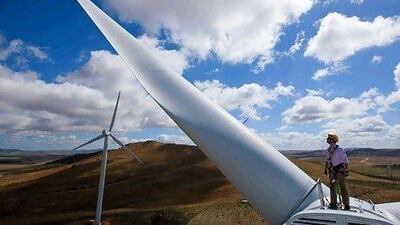Even before industrialisation created a near-unquenchable thirst for energy, agrarian societies have benefited from wind power harvested by rotary blades, as one of the most famous literary characters reminds us.
Don Quixote's famous charges at La Mancha's windmills in a novel written in the 17th century are a reminder of the longevity of this source of energy, and wind power has since attracted enough enthusiasm to become a multibillion dollar industry.
Modern wind turbines, capable of generating multiple megawatts of electricity, are also an important element of the renewable-energy targets set by the world's biggest economies. China, which recently raised its target for renewable energy to 11.4 per cent of all electricity produced, already has an installed wind power capacity of 47 gigawatts and has overtaken the US as the biggest market.
The EU has mandated that its members get a fifth of their energy from renewables by 2020, and it is expected that offshore wind farms alone will contribute 40 gigawatts to the European grid by then.
In the US, wind turbines contributed almost 44 gigawatts to the national grid last year.
But these impressive numbers hide some uncomfortable truths for turbine manufacturers.
In the US, Congress declined to renew financial help for turbine manufacturers, the production tax credit. This credit will expire by the end of the year. This would not only painfully reduce the industry's profitability, but the US government's policy shifts on the issue has already proved harmful to long-term investment planning.
"Having uncertainties in the second-largest market in the world is not good," says Morten Albaek, the group vice president at the Danish company Vestas, which has built the largest share of turbines installed worldwide and has a manufacturing base in the US. This month, Ditlev Engel, the Vestas chief executive, said the company would be forced to cut 1,600 jobs in the US if the production tax credit was not renewed.
His words were no empty threat; he announced at the same time that Vestas was shedding 2,300 jobs worldwide after poor earnings. The company already cut 3,000 jobs last year after net income slumped by 24 per cent in the third quarter.
The consultancy IHS Emerging Energy Research, based in Boston, predicts that US demand for wind turbines would be a record 10.7 gigawatts next year if the credit were extended, and only 1.5 gigawatts if the tax incentive were scrapped.
While Vestas recorded its second-best year yet in terms of sales in 2011, the established players' margins are being squeezed by increasing competition from China, where domestic turbine manufacturers receive generous state support. "China is dominated by Chinese players, and this has created an incentive for Chinese utilities to buy most of their wind farms from local manufacturers," Mr Albaek says.
While he does not expect a cutback in the tariff received by renewable-energy producers in Germany to affect the company's bottom line, the economic woes of the continent could be detrimental to the wind industry.
"A recession in Europe would impact the business," he says.
Tough competition and fiscal constraints in key markets invariably lead to a search for alternatives, and the Middle East holds some promise.
"The Middle East is important for us because we need to be in virgin markets," says Emad Ghaly, the head of wind power for the Middle East at Siemens, the world's biggest supplier of offshore wind turbines. A stroll through the vast exhibition halls of the World Future Energy Summit (WFES), held in Abu Dhabi last week, quickly showed that in the region, solar power is regarded as the best way to diversify the energy supply away from fossil fuels. Blinded by the dazzling array of shining new solar panels, a visitor would have done well to spot a solitary wind turbine model.
This picture could change at future summits, as turbine providers increasingly look to the region as a way to boost sales. In this, they are aided by a new generation of turbines geared towards slower winds, and by a gathering momentum towards alternative energy in governmental policymaking.
Abu Dhabi and Oman, as well as countries in the Levant and Maghreb, have adopted renewable-energy targets, and Egypt's and Morocco's first wind farms have started operating.
"The wind is also blowing in the Middle East - we shouldn't forget that - and there are a lot of unharvested wind resources," Mr Albaek says. Egypt is of particular interest, as wind conditions there are ideal for turbines, and the government has announced a sizeable wind-power target.
"The wind conditions in Egypt are amongst the best in the world," says Stefan Gsänger, the secretary general of the World Wind Energy Association.
But turbines designed to work at low wind speeds are also opening up opportunities in the Gulf. Solar power will remain the more opportune alternative energy source in the GCC, but even the wind-poor UAE has the potential for a few hundred megawatts of wind-generated power.
The winds of change are starting to blow. Masdar, the company owned by Mubadala Development that is responsible for bringing renewable energy to the emirate, has already tendered for a 30-megawatt wind farm in the Bani Yas region and has been considering a 100-megawatt farm near Silah. Mubadala is a strategic investment company owned by the Abu Dhabi Government.
A close relationship with Masdar, claimed by the wind giants Vestas, Siemens and GE, can also pay dividends elsewhere.
"Initiatives like Masdar are very interesting," Mr Albaek says. "They have been investing outside the UAE to create wealth for their societies. If they want to invest globally in renewable energy, we would like to be their partners."
While Vestas operates wind farms itself, the experienced player could act as a matchmaker between investor and recipient, Mr Albaek says.
Masdar's private-equity division has three funds focused on investments abroad.
Even as they are playing the green card, turbine manufacturers are not averse to benefiting from the Gulf's hydrocarbon riches.

